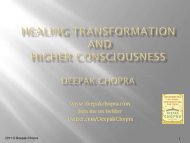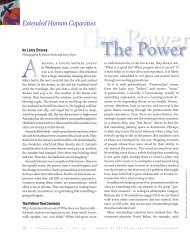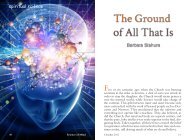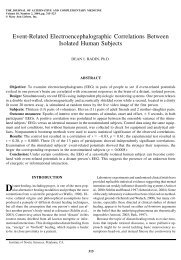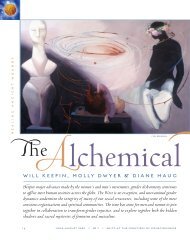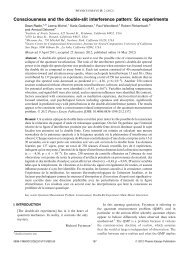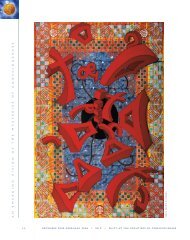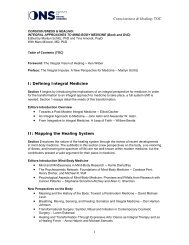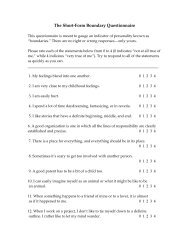Why Science Needs Art - Institute of Noetic Sciences
Why Science Needs Art - Institute of Noetic Sciences
Why Science Needs Art - Institute of Noetic Sciences
Create successful ePaper yourself
Turn your PDF publications into a flip-book with our unique Google optimized e-Paper software.
With that single sentence, as radical in sentiment as<br />
the modernist novel, James tried to shift the subject <strong>of</strong><br />
psychology. He disavowed any scientific method that<br />
tried to dissect the mind into a set <strong>of</strong> elemental units,<br />
be it sensations or synapses. Such a reductionist view is<br />
the opposite <strong>of</strong> science, James argued, since it ignores our<br />
actual reality.<br />
Modern science didn’t follow James’s lead. In the years<br />
after his textbook was published, a “New Psychology”<br />
was born, and this rigorous science had no need for<br />
Jamesian vagueness. It wanted to purge itself <strong>of</strong> anything<br />
that couldn’t be measured. The study <strong>of</strong> experience was<br />
banished from the laboratory.<br />
But artists continued creating their complex<br />
simulations <strong>of</strong> consciousness. They never gave up on<br />
the ineffable or detoured around experience because<br />
it was too difficult. They plunged straight into the<br />
pandemonium. No one demonstrates this better than<br />
James Joyce. In Ulysses, Joyce attempted to capture the<br />
mind’s present tense. Everything in the novel is seen<br />
not from the omniscient perspective <strong>of</strong> the author, but<br />
through the concave lenses <strong>of</strong> his imaginary characters.<br />
We eavesdrop on their internal soliloquies, as Bloom,<br />
Stephen, and Molly think about beauty, and death, and<br />
eggs in bed, and the number eight. This, Joyce says, is<br />
the broth <strong>of</strong> thought, the mind before punctuation, the<br />
stream <strong>of</strong> consciousness rendered on the page. Ulysses<br />
begins where William James left <strong>of</strong>f.<br />
Similarly, Samuel Taylor Coleridge, enchanted with<br />
opium, was writing poetry about the “the mind’s selfexperience<br />
in the act <strong>of</strong> thinking” long before there was<br />
even a science <strong>of</strong> the mind. Or look at the world <strong>of</strong> visual<br />
art. As the neuroscientist Semir Zeki notes, “<strong>Art</strong>ists<br />
[painters] are in some sense neurologists, studying the<br />
brain with techniques that are unique to them.” Monet’s<br />
haystacks appeal to us, in part, because he had a practical<br />
understanding <strong>of</strong> color perception. The drip paintings<br />
<strong>of</strong> Jackson Pollock resonate precisely because they excite<br />
some peculiar circuit <strong>of</strong> cells in the visual cortex. These<br />
painters reverse-engineered the brain, discovering the<br />
laws <strong>of</strong> seeing in order to captivate the eye.<br />
Of course, the standard response <strong>of</strong> science is that<br />
such art is too incoherent and imprecise for the scientific<br />
process. If it can’t be plotted on a line graph or<br />
condensed into variables, then it’s not worth taking into<br />
account. But isn’t such incoherence an essential aspect<br />
<strong>of</strong> the human mind? Isn’t our inner experience full <strong>of</strong><br />
gaps and non sequiturs and inexplicable feelings? In this<br />
sense, the messiness <strong>of</strong> the novel and the abstraction <strong>of</strong><br />
the painting are actually a mirror. As the poetry critic<br />
Randall Jarrell put it, “It is the contradictions in works<br />
<strong>of</strong> art which make them able to represent us—as logical<br />
and methodical generalizations cannot—our world and<br />
our selves, which are also full <strong>of</strong> contradictions.” Until<br />
science sees the brain from a more holistic perspective—and<br />
such a perspective might require the artistic<br />
imagination—our scientific theories will be detached<br />
from the way we see ourselves.<br />
SCIENCE AS METAPHOR<br />
At first glance, physics seems particularly remote from<br />
the subjective sphere <strong>of</strong> the arts. Its theories are extracted<br />
from arcane equations and the subatomic debris <strong>of</strong><br />
supercolliders. This science continually insists that our<br />
most basic intuitions about reality are actually illusions,<br />
a sad myth <strong>of</strong> the senses. <strong>Art</strong>ists rely on the imagination,<br />
but modern physics exceeds the imagination. To<br />
paraphrase Hamlet, there are more things in heaven and<br />
earth—dark matter, quarks, black holes—than could<br />
ever be dreamt up. A universe this strange could only<br />
be discovered.<br />
But the surreal nature <strong>of</strong> physics is precisely why it<br />
needs the help <strong>of</strong> artists. The science has progressed<br />
beyond our ability to understand it, at least in any literal<br />
sense. As Richard Feynman put it, “Our imagination is<br />
stretched to the utmost, not, as in fiction, to imagine<br />
things which are not really there, but just to comprehend<br />
those things which are there.” It’s a brute fact <strong>of</strong><br />
psychology that the human mind cannot comprehend<br />
the double-digit dimensions <strong>of</strong> string theory or the<br />
possibility <strong>of</strong> parallel universes. Our mind evolved in<br />
a simplified world, where matter is certain, time flows<br />
forward, and there are only three dimensions. When we<br />
venture beyond these innate intuitions, we are forced to<br />
resort to metaphor. This is the irony <strong>of</strong> modern physics: It<br />
seeks reality in its most fundamental form, and yet we are<br />
utterly incapable <strong>of</strong> comprehending these fundaments<br />
beyond the math we use to represent them. The only<br />
way to know the universe is through analogy.<br />
As a result, the history <strong>of</strong> physics is littered with<br />
metaphorical leaps. Einstein grasped relativity while<br />
SHIFT: AT THE FRONTIERS OF CONSCIOUSNESS • # 20 • SEPTEMBER–NOVEMBER 2008 11



